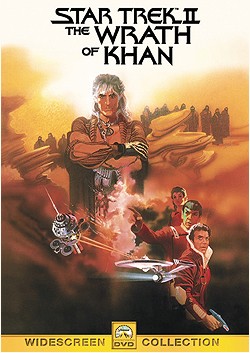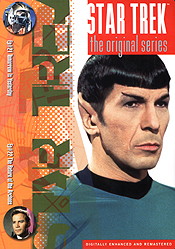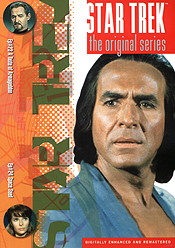 |
Site created 12/15/97.

page created: 4/25/00
Remastering the Final Frontier
or, How They Make Those Old Episodes Look So Good on DVD
 |
||
For more than 30 years, the Starship Enterprise has been boldly going where no one has gone before. In TV's original 1960s Star Trek, Captain Kirk and his stalwart crew bravely faced down Klingons, Romulans and scantily clad alien women for 79 episodes (three seasons) on NBC, before network bean-counters put the kabosh on the series. But as all good Trekkies know, that was far from the end. Soon after its cancellation, the series began appearing in television syndication and it quickly became a cult phenomenon, spawning no less than three follow-up series, a popular feature film franchise and even a Saturday morning cartoon (a fourth follow-up series is currently on the drawing board). And now Paramount Home Video is bringing the original Star Trek to DVD, along with the nine feature films. But given the enhanced picture and sound quality we've all become used to with DVD, how does one go about ensuring that a 30-year old TV series will even look marginally good on the format, much less match up to the quality of newer material on disc? Well, as I recently found out, it isn't easy. Think of it as a job worthy of Mr. Scott himself. Charged with this task at Paramount Pictures is Ron Smith, the Senior Project Manager in the studio's Digital Mastering department. When it's time to release a film on home video, he's the guy responsible for supervising the quality of the film-to-video transfer. And when it comes to making Star Trek look and sound great on DVD, the buck stops with him. |
||
|
||
Ron's interest professionally is in restoring classic films. When he first arrived at Paramount, he found himself working to transfer the studio's A-list titles and its feature film catalog as well. He's worked to create new digital masters of many of these films, for broadcast and home video use, in the highest possible quality using the latest digital techniques. He's mastered countless titles for VHS and laserdisc, Trek included. "It wasn't long before I got involved in the work to bring the Trek films and episodes to home video," Ron says. And now with DVD, he's looking at Star Trek with an even more critical eye. |
||
|
||
Once the video passed muster, the next step was to upgrade the audio. As Ron explains, "Seventy-five percent of what we're doing is really restoration - we're cleaning up the original sounds and bringing them out." The first step is to remove the analog tape hiss from each episode's three audio tracks, in a process called strip-silencing. "Basically, when you run the three audio tracks together, whenever one of them isn't playing back an actual sound, it hisses, because the mag is still running. So when you simply take away all the hiss from the original tracks, suddenly all you're left with is the original sounds as you were meant to hear them." Beyond that, Ron and his staff work to clean up the sound edits in the mix - the various noises that are simply a result of the imperfect techniques used to edit movie and TV sound back in the 70s. Today, for example, a sound mixer can digitally cross-fade music and sound effects cues into the mix. The result is a clean-sounding transition, rather than a faint pop where a physical edit occurs in older material. But as you know, that isn't all that's being done to the audio. For DVD, Paramount has decided to upgrade the sound to 5.1 from the original mono split tracks. Much of that work is being done at Pacific Ocean Post Sound, with the help of sound mixer Ted Hall. The exact process involved is something of a secret at Paramount - it's part of the bag of tricks that each audio engineer hides up their sleeves with pride. But the basic idea is simple. With today's digital equipment, the various sounds in the mono tracks can be extrapolated to create a three-dimensional sound environment for home theater. "What we're doing for DVD is creating ambiences," Ron notes, "which is what Star Trek is about. There's a sound for everything on the show. There's a sound for the Bridge, a sound for inside the turbolifts, for each individual planet - every room and location. That's really what makes the show immediately identifiable. It's part of creating the space." The result is tremendous - the enhanced surround sound adds just the right amount of gee-whiz to the DVD experience, and helps to make the episodes fresh again for those of us (and I know you're with me on this) who have seen them dozens of times over the years. But the process is definitely time consuming. Each episode can be in production for DVD for as long as six months, and multiple episodes are in progress at any given time, in various stages of completion. Ron and his crew are currently working their way through the series, having recently completed episode 28 (that's the award-winning The City on the Edge of Forever for you non-Trekkies). The first twenty episodes have already been released on DVD. Volumes 11 and 12 of the series on DVD are expected to be released in May (including the classic episode Space Seed), and Volumes 13 and 14 should arrive in July if all goes well (FYI - I'm told that sales of the episodes thus far on DVD have been brisk). Also expected in July is the best (and most eagerly-awaited) film in the series, Star Trek II: The Wrath of Khan. It's been given a new high-definition film transfer (yes, Virginia... it will be anamorphic), and Ron's crew is currently working to create a brand new Dolby Digital 5.1 soundtrack for the disc. For you picky detail folks out there, the disc will include the original theatrical version of the film, along with a trailer. The studio is also working on Star Trek: The Motion Picture for later this year, although it's unclear at this time if it will be the theatrical version, or the longer "special edition". Non-studio sources tell me that one of the problems with the original film, is that many of the special edition scenes don't include finished effects shots - that's why a widescreen version of it has never been available on home video before (you can get away with seeing a bit of the unfinished sets in full frame, but widescreen would show too much). To do an anamorphic widescreen DVD, these scenes would have to be digitally finished - a time-consuming process. Still, I'm told that the disc will also feature remixed 5.1 sound. And, says Ron, "we're definitely committed to bringing it to DVD in the highest quality." |
||
 Star Trek II: The Wrath of Khan... coming to DVD in July. |
||
| As for the rest
of the Trek franchise coming
to DVD, Ron and his staff are just starting to look at episodes of
Star Trek: The Next Generation,
although nothing has been finalized as yet. "We're just
developing our game plan in terms of bringing them to DVD," he
says. It will be a somewhat different process, because that series
was finished on videotape - not film. And while the later episodes
were digitally-mastered, the first season or two were done in analog
format, which may mean that additional work is necessary. In any
case, Paramount assures me that they're coming, but probably not
until the fall at the earliest. As for Deep
Space Nine and Voyager,
there are no plans as yet. I also asked about the chances of Star
Trek VI and Generations
being revisited with anamorphic transfers on DVD in the future, and
received no comment. But as Paramount Home Video spokesman Martin
Blythe says, "The future of Star
Trek on DVD is very bright indeed...." So there you
have it. I hope you all enjoyed this little look behind-the-scenes at the efforts to bring Star Trek to DVD. The Digital Bits would like to thank Ron Smith, Jeff Radoycis and Martin Blythe of Paramount for their time and assistance with this story. Keep on Trekkin', folks! As always, I welcome your comments. Bill Hunt, Editor The Digital Bits billhunt@thedigitalbits.com |

| Site
designed for 800 x 600 resolution, using 16M colors and .gif 89a
animation. © 1997-2015 The Digital Bits, Inc., All Rights Reserved. billhunt@thedigitalbits.com |

